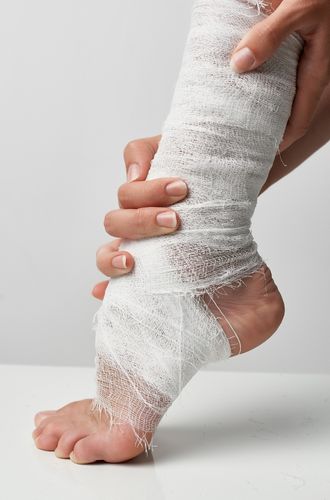
If you’re dealing with an infection, injury, or other condition that’s impacting your lower extremity, then lower limb reconstruction surgery may be an option for you. This type of reconstructive surgery can help to improve the function and appearance of your leg. Dr. Nilesh Satbhai has years of experience in performing lower limb reconstruction procedures. Dr. Nilesh will work with you to develop a treatment plan that meets your specific needs and helps you get back to living life to the fullest.
Lower limb reconstruction is a surgical procedure to restore limb function, cover vital structures, and maintain a satisfactory appearance following infection, injury, or metabolic or vascular diseases.
Reconstructive surgery is needed to correct dysfunction and the form of the lower extremity that is caused by a variety of etiologies, including trauma, infection, non-healing wounds, malignancy, degenerative disease, or congenital deformities.
In limb reconstruction surgery, surgeons use a variety of techniques to improve the shape, length, and function of a limb by realigning bones and their correct positioning or stabilizing joints and sometimes making bones longer.
The following is a system for classifying lower limb wounds based on their severity:
Grade 1: Open fracture with a wound less than 1 cm long and clean.
Grade 2: Open fracture with a laceration more than 1 cm long without extensive soft tissue damage, flaps, or avulsion.
Grade 3: Open fracture with extensive soft tissue damage.
Multiple causes may threaten your lower extremity, including:
Lower limb reconstruction is ideal for individuals who have open wounds or defects in a lower limb due to trauma, tumor, or congenital abnormalities. Some subjects for this treatment include:
Other types of injuries that require reconstruction are:
If you have any of the above wounds or defects, book an appointment with Dr. Nilesh Satbhai in Mumbai immediately.
Request AppointmentDuring the consultation for lower limb reconstruction, a thorough physical examination of the lower extremity will be done by Dr. Nilesh Satbhai . Dr. Nilesh will also recommend radiographic examination, including:
Dr. Nilesh Satbhai will determine the most suitable treatment for you based on the grade of your injury, infection status, and the presence of other conditions.
You will be initially evaluated and cared for within guidelines, including:
Before determining that a limb is completely unconscious, such injuries should be managed with debridement, nerve repair (whether primary or with nerve grafts), tendon repair, tissue flaps, and orthopedic fixation when applicable. Let’s understand them one by one:
Debridement involves cleaning the wound by removing all the dead, necrotic, or hyperkeratotic tissue. Common indications for sharp surgical debridement are:
The nerves of the lower limb originate from L2 through S2 spinal levels, forming the lumbosacral plexus. The major nerves are:
The techniques used for nerve repair include the following:
End-to-end repair: End-to-end repair is the process of suturing the ends of a nerve together. This is typically used for small nerve gaps.
Nerve grafting: With this procedure, the doctor transplants a healthy nerve from another area of the body to the damaged nerve site.
Nerve transfers: In this surgery, the doctor attaches a nearby healthy nerve to the damaged one.
Nerve decompression: Nerve decompression is a procedure to relieve pressure on a nerve.
Neurolysis under magnification: This is a type of nerve decompression done to relieve nerve compression caused by adhesions, scar tissue, or callus.
Tendon injury in the lower limb is a common occurrence. The most frequently injured tendons are:
Tendon repair is done by suturing the torn ends of the tendon. In some cases, tendon reconstruction may be necessary. This is done by attaching the tendon to another healthy tendon or bone.
Tissue flaps are a type of reconstructive surgery where the surgeon moves healthy tissue from one area of the body to another. The following procedures can be done for lower limb reconstruction. The commonly used tissue flaps are:
Fasciocutaneous flaps are tissue flaps that include skin, subcutaneous tissue (bottom layer of the skin), and the underlying connective tissue.
The most popular fasciocutaneous flap for many reasons is the anterolateral thigh (ALT) flap. It provides a good coverage solution for most lower limb defects as it is a very large flap with a long pedicle.
The ALT flap could be raised from the contralateral leg without intraoperative repositioning. It can be taken as a thin flap (or can be thinned after being raised) to provide a low-profile solution to tissue defects around the ankle and foot.
Muscle flaps are tissue flaps that include muscle, tendons, and the overlying skin. Muscle flaps are used to cover large wounds or defects.
Based on the largest muscle in the body, the latissimus dorsi (LD) flap is used when a large area is required. It has a long pedicle and can be quick to raise.
Wounds around the knee may be covered by using the medial or lateral head of a gastrocnemius muscle flap.
Defects around the knee and lower thigh can also be reconstructed with a lateral genicular artery muscle flap. Although free flaps are not typically used in this region, they remain an option when additional flaps are unavailable.
The following steps are performed to prepare the wound before the surgery:
The basic principles of bone fixation are:
Bone fixation can be done by:
Internal fixation: Internal fixation is a type of surgery where metal screws, plates, or rods are placed internally to hold the bone in place while it heals.
External fixation: External fixation is a type of surgery where metal pins are inserted into the bone and connected to a frame on the outside of the body.
Plaster immobilization: This is a type of external fixation where the plaster cast is used to hold the bone in place while it heals.
If bone contamination is remarkable or there is a concern for ongoing infection, then fractures require external fixation as the definitive treatment until the bone heals properly. Some important soft tissue reconstruction principles that are considered with the placement of external fixation pins and bars are as follows:
After bone stabilization, tibial defects may be reconstructed using a variety of flaps. In general, the tibial region is divided into three parts:
Recovery is usually prolonged, and it involves intense rehabilitation and physical therapy to:
The recovery period is dependent on the wound treated and the actual treatment option employed.
The cost of lower limb reconstruction will depend on the severity of the damage to the limbs and the type of treatment that is required. Dr. Nilesh Satbhai will give you a more accurate estimate of the cost after assessing the situation.
Request AppointmentLower limb reconstruction can improve the function and appearance of the affected extremity. It can also help to prevent further complications such as infection, joint contractures, and amputation.
Lower limb reconstruction can also help to improve the quality of life for patients by restoring their ability to walk, run, and participate in activities they enjoy.
While lower limb reconstruction surgery can be life-changing, it is also associated with some risks. The most common complications of lower limb reconstruction include infection, blood clots, and nerve damage. For this reason, it is important to consult with a qualified surgeon like Dr. Nilesh Satbhai before undergoing this type of surgery. With careful planning and execution, the risks associated with lower limb reconstruction can be minimized.

MBBS, MS, MCh
